MASS Meeting Notes for February 24, 2017
This was our 50th meeting! Boy, time sure flies when you’re having a good time! Keith, Silvio, Harry, Dave, Phil, Dean and I were in attendance. Since it had been 15 long weeks since our last meeting, we spent quite a bit of time catching up on what people had been up to.
Dean made a great presentation on the history of US Mars exploration at the Villa Park Library on January 30th. As a complimentary resource, I’ve included a graphic that does a great job in showing all the space probes sent to Mars from all 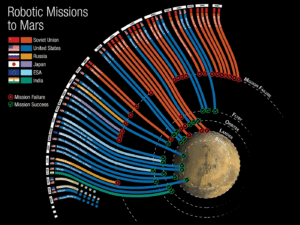 countries and whether they were a success or not. The graphic doesn’t have the update that the recent 2016 European ExoMars orbiter (Russia provided the launch rocket) was a success but the demonstration Scaparelli lander, included on the mission, crashed into the surface of Mars.
countries and whether they were a success or not. The graphic doesn’t have the update that the recent 2016 European ExoMars orbiter (Russia provided the launch rocket) was a success but the demonstration Scaparelli lander, included on the mission, crashed into the surface of Mars.
Phil told us that he has planned a visit to the Kennedy Space Center. It sounds like it will be a thorough exploration of the site with a “Lunch with an Astronaut” event and a launching of a Delta IV rocket with a Defense Department satellite on March 8th. We all wished him good weather.
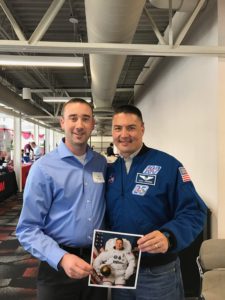 My son Curt this week met up with astronaut Kjell Lindgren at a conference where Kjell made the presentation “Safety in Space”. Kjell was kind enough to pose for a picture and sign a photograph as a souvenir. Kjell was on the ISS during the later half of 2015 while Scott Kelly was performing his “One Year in Space” mission.
My son Curt this week met up with astronaut Kjell Lindgren at a conference where Kjell made the presentation “Safety in Space”. Kjell was kind enough to pose for a picture and sign a photograph as a souvenir. Kjell was on the ISS during the later half of 2015 while Scott Kelly was performing his “One Year in Space” mission.
We announced that Dean has rescheduled his talk about the pre-Space Age observation of Mars at the Villa Park Library to March 27th.
Dave told us he will be driving his school bus to pick up the astronomy class of the Universary of Chicago at Yerkes Observatory near Geneva, WI this coming Sunday. Unfortunately we don’t think the observatory will be open to the general public on that day, so his offer to take us up there might not result in an opportunity to tour the facility.
Other topics we discussed were,
- Meteor seen from western suburbs – It was sited about 1:30 AM on Monday, Feb 6th and landed in Lake Michigan off Sheboygan or possibly burned up before landing. It had a green color and gave off a sonic boom. It was maybe .6 meters in size (about 2 ft), weighed 600# and was traveling at 38,000 mph before it broke into smaller pieces about 21 miles high. It first appeared about 62 miles high.
- Neil DeGrasse Tyson has a new book “Welcome to the Universe” – The book has a great chapter on Drake equation. The number of exoplanets is now known much better because of Kepler mission. The latest numbers for the Drake Equation yield 100 communicating civilizations in Milky Way. Later chapters on relativity and such by his co-authors are really tough to comprehend. The book is available at the Villa Park Library and I recommend it highly. It was the textbook used for introductory astronomy class at Princeton taught by Neil and the co-authors.
- John Glenn dies – The last of the Mercury 7 astronauts dies on Dec 8, 2016 at age 95. He first launched at age 40 on Feb 20, 1962, which was 2 days after my 13th birthday, for 3 orbits. He flew again on the shuttle in 1998 on a 9 day mission. He was a senator at the time (his service was for 24 years 1974-1999) from Ohio. His first flight had issue if the heat shield was loose. Bezos new rocket is called New Glenn.
- Vera Rubin who confirmed dark matter dies at 88 – Her work studying the rotation of stars in the Andromeda galaxy was instumental in convincing people that dark matter must exist.
- Gene Cernan dies – A bill has been entered to name the first SLS rocket after him. It will be called “Cernan 1”. He passed away on Jan 16, 2017 at the age of 82. He was a veteran of Gemini 9, Apollo 10 and Apollo 17 missions. He was last man to walk on the moon (his LEM took off from the moon on Dec 14, 1972). I definitely want to see “The Last Man on the Moon” a documentary released a couple of years ago based on his 1999 book. He was in favor of a return to the moon for NASA, disagreeing with President Obama’s “been there done that” dismissal of additional exploration of the moon.
- Trump Plans for NASA??? – Nice graph showing NASA budget as % of
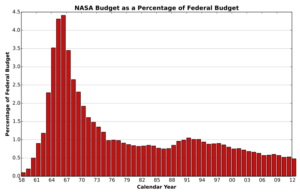 Federal budget. Those who have early mention as NASA head include 1) Eileen Collins – she spoke a Republican Convention, ex-astronaut, critical of Obama cancelling Constellation, 2) Jim Bridenstine (R-OK) 3rd term Congressional Rep, has seats on House Science Committee and House Armed Services Committee introduced “American Space Renaissance Act”, 3) Mark Albrecht was executive secretary of National Space Council under Bush, published an insider account of Space Exploration Initiative & Vision for Space Exploration. Issues needing prioritization: SLS/Orion, Commercial cargo and crew, ISS, Mars or Moon exploration, transfer Earth study to NOAA (10% of NASA’s budget now).
Federal budget. Those who have early mention as NASA head include 1) Eileen Collins – she spoke a Republican Convention, ex-astronaut, critical of Obama cancelling Constellation, 2) Jim Bridenstine (R-OK) 3rd term Congressional Rep, has seats on House Science Committee and House Armed Services Committee introduced “American Space Renaissance Act”, 3) Mark Albrecht was executive secretary of National Space Council under Bush, published an insider account of Space Exploration Initiative & Vision for Space Exploration. Issues needing prioritization: SLS/Orion, Commercial cargo and crew, ISS, Mars or Moon exploration, transfer Earth study to NOAA (10% of NASA’s budget now). - SpaceX announces cause of Sep 1st explosion – pressure vessel inside the 2nd stage oxygen tank containing cold helium ruptured when liquid oxygen outside the vessel worked its way in between the aluminum tank and its carbon fiber liner. Fuel ignited by breaking fibers or friction. SpaceX will in the short term will use warmer helium and in long term change the tank to prevent buckles allowing faster fuel loading operations. SpaceX’s use of supercooled fuel also contributes to the problem.
- SpaceX teases a photo of Falcon Heavy Logo – logo on the interstage which connects the first and second stages of the booster. SpaceX targeting early to mid 2017 for launch from pad at Launch Complex 39A which is almost ready to accept the new rocket. Here is an aerial map of launch pads.
Rocket would be by a factor of 2 the most powerful by doubling the capacity of the Delta IV Heavy. Composed of 3 Falcon 9’s with a total of 27 engines. Some consider to complex to be reliable. They fear to similar to N1 booster of the Soviets with its 30 engines that suffered 4 failures in its launches with no successes between 1969 and 1972. But the rocket could disrupt the heavy lift launch market. NASA’s SLS won’t launch until late 2018. Although SLS has more lift capability 70 mt to 54, it will also cost 10 times as much. Charles Miller on Trump’s transition team has already led an extensive study of lunar exploration relying on the Falcon Heavy. First successful land landing 12/21/15 then did 4 at sea and another on land in 2016. 12-02 Falcon 9 to launch 10 Iridium satellites on Jan 8, 2017 from Vandenberg. Had 8 successful launches in 2016.
- Elon Musk running outside his launch blockhouse to see Falcon9 land back in Florida – The video is in the window with “SpaceX Makes History | MARS”. I saw this video click originally during the Mars show on National Geographic (which was a little disappointing but they did find life on Mars after a crazy person blew half of the lab apart). Musk’s enthusiasm is contagious.
- Falcon 9 Block 5 – last upgrade to Falcon 9 ( v1.0, v1.1 R v1.1 and Full Thrust) Full Thrust used Merlin 1-D engines and chilled densified propellant to give 30% lift performance. Block 5 will increase performance enough so that a satellite launch like EchoStar 23 (5.5 mt to geosynchronous orbit) could still recover the first stage. Jan 30, 2017 launch will be an expendable first stage. Block 5 also improves reusability and will fly before end of 2017. Seven returned first stages will only be used a couple of times. First reused booster is scheduled for SES-10 satellite launch possible in March 2017. Problems will engines on returned boosters will be overcome on Block 5 version which could be reused indefinitely after maintenance and careful inspections.
- New MASS Prize – We were too optomistic the first time around. We needed a second chance to try to guess when astronauts will launch from US soil and dock with the ISS. This time we are trying to guess down to the day when the astronauts will enter the ISS. Guesses range from Jim A.’s 8/2/2017 to Sophia, his wife’s 1/7/2020. SpaceX is currently planning to launch its first crew on May 2018 and Boeing plans are for August 2018. See the section of the website “MASS on Commercial Crew” to see the details of the guesses. Good luck to all. Who would have guessed that out of 12 guesses, 3 would be 7/4/2018.
- NASA announces 7 Earth sized exoplanets around Trappist-1 star 40 ly away – We watched the original 20 minute NASA press conference from Feb 22, 2017. It was best to hear the news directly from the scientists involved with the studies. The Trappist telescope in Chile is studying the 60 closest ultra cool dwarf stars. It initially discovered the first 3 exoplanets in the system with the Spitzner space telescope following up and discovering that there were actually 7 exoplanets in the system. 3 of the planets are in habitable zone where liquid water could exist if the atmosphere permits. An upgraded capability Spitzner Infrared telescope detected planetary occultations of the star like the Kepler telescope does. The closest habitable orbit is only 5% the size of earth’s orbit. Orbits range from 1.5 to 20 days. The planets are so close that they gravitationally interact while they orbit. 1995 was when the first exoplanet was discovered. Now there are ~3600 confirmed exoplanets. Of those about 4 dozen are in the habitable zone and only 18 of them are earth-sized. NASA has been very busy conjecturing through space art what the exoplanet surfaces look like. The nearest star, Proxima Centauri, is 4.25 lightyear awa. Trappist-1 is 9.3 times farther at 39.5 lightyears. If the Solar Probe Plus probe going at 450,000 mph (125 mps) could be flung out of the Solar System at that speed, it would take 59,500 years for it to reach Trappist-1 or 6400 years to reach Proxima Centauri. (5.9 trillion miles in a lightyear)
For our main topic we watched “The Dark Side of the Sun” which was on the Science Channel on 2/12/2017. The program talks of Solar Probe Plus (launch in August 2018 on Delta IV heavy) which will achieve a speed of 450,000 mph (125 mps) as it orbits as close as 4 million miles of the sun (9 times closer than Mercury’s average distance). It will execute 7 flybys of Venus. The probe survives with a 4.5 inch thick carbon composite shield which withstands 2500 degree temperatures and DKIST (Daniel K. Inouye Solar Telescope) the world’s largest solar telescope being built in a National Park in Hawaii.
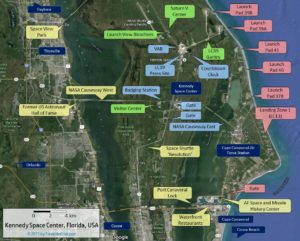
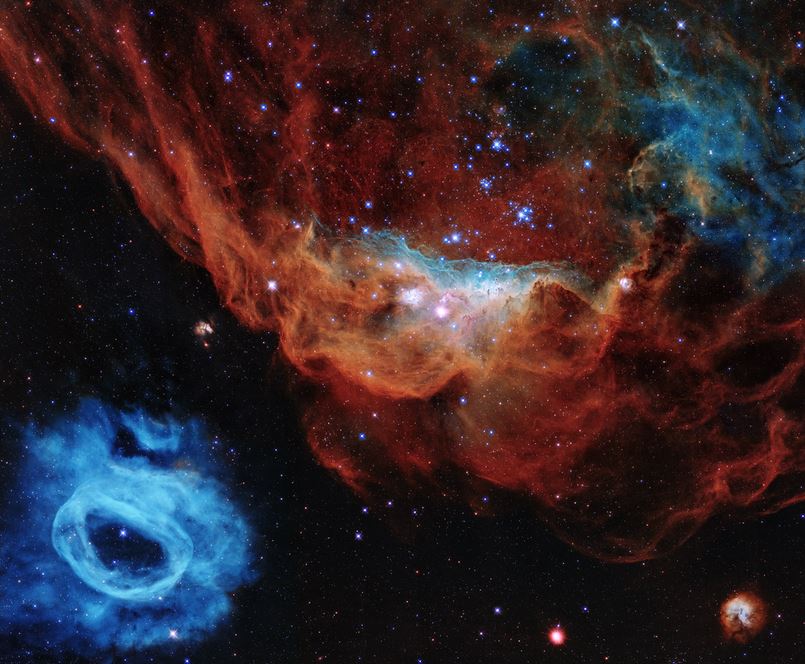
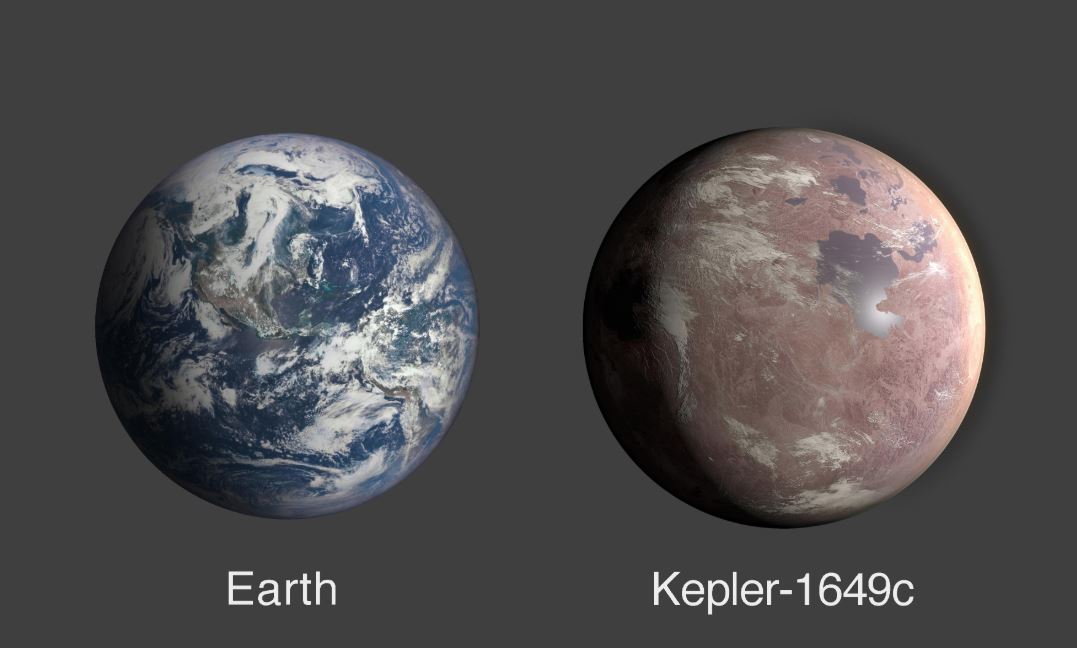
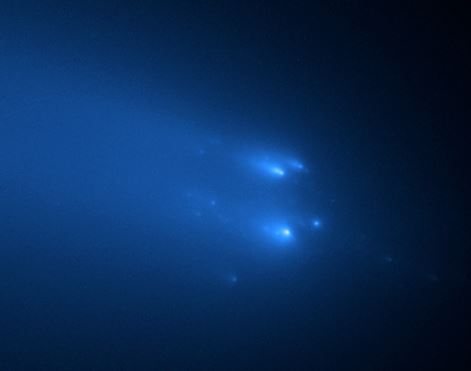
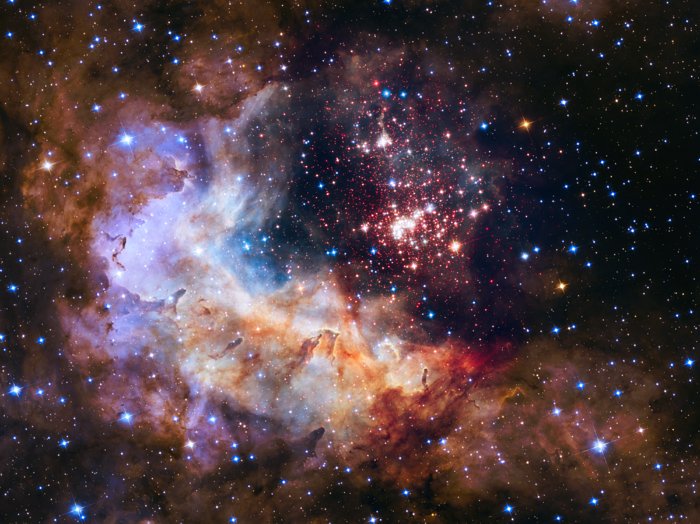

One Response
A great update, as always Jim! We all appreciate the efforts. You always provide a “one-stop-shop” information hub in your articles we’ve always enjoyed. Sharing and enjoying!
Thanks again!
-Keith
Comments are closed.